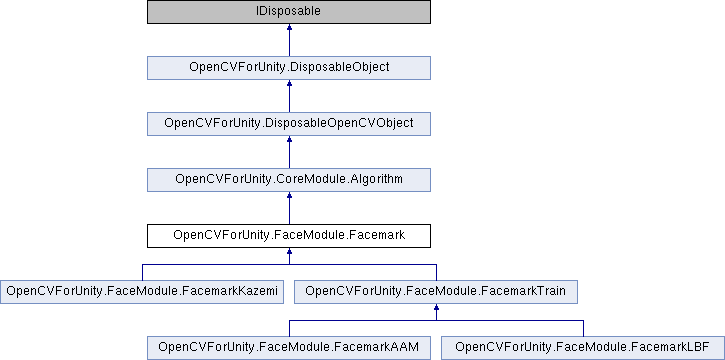Abstract base class for all facemark models. More...

Public Member Functions | |
| void | loadModel (string model) |
| A function to load the trained model before the fitting process. More... | |
| bool | fit (Mat image, MatOfRect faces, List< MatOfPoint2f > landmarks) |
| Detect facial landmarks from an image. More... | |
 Public Member Functions inherited from OpenCVForUnity.CoreModule.Algorithm Public Member Functions inherited from OpenCVForUnity.CoreModule.Algorithm | |
| IntPtr | getNativeObjAddr () |
| virtual void | clear () |
| Clears the algorithm state. More... | |
| virtual bool | empty () |
| Returns true if the Algorithm is empty (e.g. in the very beginning or after unsuccessful read. More... | |
| void | save (string filename) |
| virtual string | getDefaultName () |
 Public Member Functions inherited from OpenCVForUnity.DisposableObject Public Member Functions inherited from OpenCVForUnity.DisposableObject | |
| void | Dispose () |
| void | ThrowIfDisposed () |
Static Public Member Functions | |
| static new Facemark | __fromPtr__ (IntPtr addr) |
 Static Public Member Functions inherited from OpenCVForUnity.CoreModule.Algorithm Static Public Member Functions inherited from OpenCVForUnity.CoreModule.Algorithm | |
| static Algorithm | __fromPtr__ (IntPtr addr) |
 Static Public Member Functions inherited from OpenCVForUnity.DisposableObject Static Public Member Functions inherited from OpenCVForUnity.DisposableObject | |
| static IntPtr | ThrowIfNullIntPtr (IntPtr ptr) |
Protected Member Functions | |
| override void | Dispose (bool disposing) |
 Protected Member Functions inherited from OpenCVForUnity.DisposableOpenCVObject Protected Member Functions inherited from OpenCVForUnity.DisposableOpenCVObject | |
| DisposableOpenCVObject () | |
| DisposableOpenCVObject (IntPtr ptr) | |
| DisposableOpenCVObject (bool isEnabledDispose) | |
| DisposableOpenCVObject (IntPtr ptr, bool isEnabledDispose) | |
 Protected Member Functions inherited from OpenCVForUnity.DisposableObject Protected Member Functions inherited from OpenCVForUnity.DisposableObject | |
| DisposableObject () | |
| DisposableObject (bool isEnabledDispose) | |
Additional Inherited Members | |
 Properties inherited from OpenCVForUnity.DisposableObject Properties inherited from OpenCVForUnity.DisposableObject | |
| bool | IsDisposed [get, protected set] |
| bool | IsEnabledDispose [get, set] |
Detailed Description
Abstract base class for all facemark models.
To utilize this API in your program, please take a look at the tutorial_table_of_content_facemark
Description
Facemark is a base class which provides universal access to any specific facemark algorithm. Therefore, the users should declare a desired algorithm before they can use it in their application.
Here is an example on how to declare a facemark algorithm:
The typical pipeline for facemark detection is as follows:
- Load the trained model using Facemark::loadModel.
- Perform the fitting on an image via Facemark::fit.
Member Function Documentation
◆ __fromPtr__()
|
static |
◆ Dispose()
|
protectedvirtual |
Reimplemented from OpenCVForUnity.CoreModule.Algorithm.
Reimplemented in OpenCVForUnity.FaceModule.FacemarkTrain, OpenCVForUnity.FaceModule.FacemarkAAM, OpenCVForUnity.FaceModule.FacemarkKazemi, and OpenCVForUnity.FaceModule.FacemarkLBF.
◆ fit()
| bool OpenCVForUnity.FaceModule.Facemark.fit | ( | Mat | image, |
| MatOfRect | faces, | ||
| List< MatOfPoint2f > | landmarks | ||
| ) |
Detect facial landmarks from an image.
- Parameters
-
image Input image. faces Output of the function which represent region of interest of the detected faces. Each face is stored in cv::Rect container. landmarks The detected landmark points for each faces. <B>Example of usage</B>
Mat image = imread("image.jpg");std::vector<Rect> faces;std::vector<std::vector<Point2f> > landmarks;facemark->fit(image, faces, landmarks);
◆ loadModel()
| void OpenCVForUnity.FaceModule.Facemark.loadModel | ( | string | model | ) |
A function to load the trained model before the fitting process.
- Parameters
-
model A string represent the filename of a trained model. <B>Example of usage</B>
facemark->loadModel("../data/lbf.model");
The documentation for this class was generated from the following file:
- OpenCVForUnity/Assets/OpenCVForUnity/org/opencv_contrib/face/Facemark.cs
 1.8.14
1.8.14